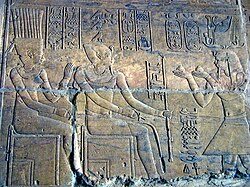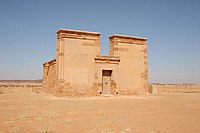Arqamani
| Arqamani | |||||||||||||||||||||||||||||||||||||||||||||
|---|---|---|---|---|---|---|---|---|---|---|---|---|---|---|---|---|---|---|---|---|---|---|---|---|---|---|---|---|---|---|---|---|---|---|---|---|---|---|---|---|---|---|---|---|---|
 Arqamani (right) presenting an offering, from theTemple of Dakka | |||||||||||||||||||||||||||||||||||||||||||||
| Pharaoh | |||||||||||||||||||||||||||||||||||||||||||||
| Reign | late 3rd to early 2nd Century BCE | ||||||||||||||||||||||||||||||||||||||||||||
| Predecessor | Arnekhamani | ||||||||||||||||||||||||||||||||||||||||||||
| Successor | Adikhalamani | ||||||||||||||||||||||||||||||||||||||||||||
| |||||||||||||||||||||||||||||||||||||||||||||
| Burial | Pyramid atMeroë:Beg. N 7 | ||||||||||||||||||||||||||||||||||||||||||||
Arqamani(alsoArkamaniorErgamenes II[2]) was aKushite KingofMeroëdating from the late 3rd to early 2nd century BCE.
Biography
[edit]It is believed that Arqamani ruled in Meroë at the time of theEgyptianrevolt ofHorwenneferagainstPtolemy IV Philopator(reign 221–204 BC).[2]He is attested by a number of inscriptions and reliefs fromKalabsha,Philaeand thetemple of Dakka.[3]In the latter locality, he usurped some donation inscriptions originally inscribed for Ptolemy IV.[4]He was buried in apyramid in Meroënow known as Beg. N 7.[5]
Arqamani took an elaborateancient Egyptian royal titulary(see infobox) which likely reflects his control above the reconqueredLower Nubiaand its inhabitants.[2]He also took mortuary names: the mortuary Horus name isKashy-netjery-kheper,meaning "The Kushite whose coming into being is divine", while his nomen is accompanied by the epithetAnkhdjet-meriaset,meaning "Given life, beloved ofIsis",as well asMkltk Istrkwhich is written inMeroitic scriptand whose meaning is not known.[5]
He was sometimes tentatively identified with the kingErgamenesmentioned byDiodorus Siculusbut modern scholars now believe that an earlier king with a similar name,Arakamani,is a better candidate for this identification.[6]Nevertheless, Arqamani is sometimes called Ergamenes II.
-
Temple of Apedemakin Musawwarat es-sufra, built by Arnekhamani
-
Prince Arka, son ofArnekhamani,and possibly identical with Arqamani.[7]
-
Pyramid of King Arqamani,Meroe Northern Cemetery
See also
[edit]References
[edit]- ^abvon Beckerath, Jürgen(1999).Handbuch der Ägyptischen Königsnamen(in German). Mainz am Rhein, Von Zabern.ISBN3-8053-2591-6.pp. 276-77
- ^abcTörök (2008), p. 393
- ^J. Desmond Clark (1975).The Cambridge history of Africa.Cambridge University Press. pp. 228, 241.ISBN978-0-521-21592-3.Retrieved17 March2011.
- ^Török (2008), p. 388
- ^abLászló Török, The kingdom of Kush: handbook of the Napatan-Meroitic Civilization, 1997
- ^Török (2008), pp. 389–90 and references therein.
- ^Török, László (1996).Fontes Historiae Nubiorum,Vol. II. Bergen.ISBN8291626014., p. 582
Further reading and Bibliography
[edit]- Török, László (1996).Fontes Historiae Nubiorum, Vol. II.Bergen.ISBN8291626014.,pp. 660–662
- Török, László (2008).Between Two Worlds: The Frontier Region Between Ancient Nubia and Egypt 3700 BC - 500 AD.Brill.ISBN978-90-04-17197-8.


![Prince Arka, son of Arnekhamani, and possibly identical with Arqamani.[7]](https://upload.wikimedia.org/wikipedia/commons/thumb/6/67/Prince_Arka.jpg/116px-Prince_Arka.jpg)

